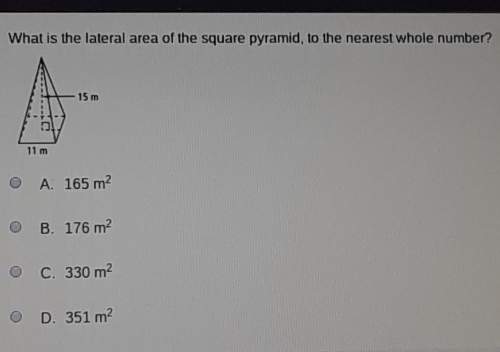Letp(n)bethestatementthat13 +23 +⋯+n3 = (n(n+ 1)∕2)2 for the positive integer n.
a) what is t...

Mathematics, 18.11.2019 20:31, T0othless3clipes
Letp(n)bethestatementthat13 +23 +⋯+n3 = (n(n+ 1)∕2)2 for the positive integer n.
a) what is the statement p(1)?
b) show that p(1) is true, completing the basis step of the proof of p(n) for all positive integers n.
c) what is the inductive hypothesis of a proof that p(n) is true for all positive integers n?
d) what do you need to prove in the inductive step of a proof that p(n) is true for all positive integers n?
e) complete the inductive step of a proof that p(n) is true for all positive integers n, identifying where you use the inductive hypothesis.
f) explain why these steps show that this formula is true whenever n is a positive integer.

Answers: 2
Other questions on the subject: Mathematics

Mathematics, 21.06.2019 20:00, collinpeterson21
Question 3 (essay worth 10 points) (03.06 mc) part a: max rented a motorbike at $465 for 5 days. if he rents the same motorbike for a week, he has to pay a total rent of $625. write an equation in the standard form to represent the total rent (y) that max has to pay for renting the motorbike for x days. (4 points) part b: write the equation obtained in part a using function notation. (2 points) part c: describe the steps to graph the equation obtained above on the coordinate axes. mention the labels on the axes and the intervals. (4 points)
Answers: 1

Mathematics, 21.06.2019 21:00, joshuasanders8862
You have 12 balloons to blow up for your birthday party. you blow up 1/3, and your friend blows up 5 of them. what fraction of the baloons still need blowing up
Answers: 1

Mathematics, 21.06.2019 22:30, thelonewolf5020
Amachine that produces a special type of transistor (a component of computers) has a 2% defective rate. the production is considered a random process where each transistor is independent of the others. (a) what is the probability that the 10th transistor produced is the first with a defect? (b) what is the probability that the machine produces no defective transistors in a batch of 100? (c) on average, how many transistors would you expect to be produced before the first with a defect? what is the standard deviation? (d) another machine that also produces transistors has a 5% defective rate where each transistor is produced independent of the others. on average how many transistors would you expect to be produced with this machine before the first with a defect? what is the standard deviation? (e) based on your answers to parts (c) and (d), how does increasing the probability of an event a↵ect the mean and standard deviation of the wait time until success?
Answers: 3

Mathematics, 22.06.2019 00:00, egirl7838
Titus works at a hotel. part of his job is to keep the complimentary pitcher of water at least half full and always with ice. when he starts his shift, the water level shows 4 gallons, or 128 cups of water. as the shift progresses, he records the level of the water every 10 minutes. after 2 hours, he uses a regression calculator to compute an equation for the decrease in water. his equation is w –0.414t + 129.549, where t is the number of minutes and w is the level of water. according to the equation, after about how many minutes would the water level be less than or equal to 64 cups?
Answers: 2
Do you know the correct answer?
Questions in other subjects:


Mathematics, 28.07.2019 12:30

English, 28.07.2019 12:30






Health, 28.07.2019 12:30

History, 28.07.2019 12:30







